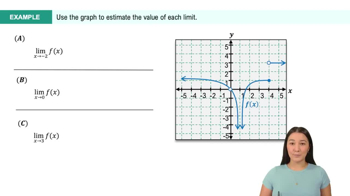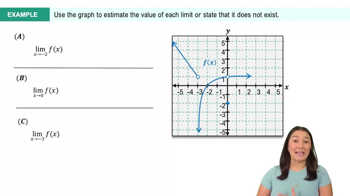Table of contents
- 0. Functions7h 52m
- Introduction to Functions16m
- Piecewise Functions10m
- Properties of Functions9m
- Common Functions1h 8m
- Transformations5m
- Combining Functions27m
- Exponent rules32m
- Exponential Functions28m
- Logarithmic Functions24m
- Properties of Logarithms34m
- Exponential & Logarithmic Equations35m
- Introduction to Trigonometric Functions38m
- Graphs of Trigonometric Functions44m
- Trigonometric Identities47m
- Inverse Trigonometric Functions48m
- 1. Limits and Continuity2h 2m
- 2. Intro to Derivatives1h 33m
- 3. Techniques of Differentiation3h 18m
- 4. Applications of Derivatives2h 38m
- 5. Graphical Applications of Derivatives6h 2m
- 6. Derivatives of Inverse, Exponential, & Logarithmic Functions2h 37m
- 7. Antiderivatives & Indefinite Integrals1h 26m
1. Limits and Continuity
Introduction to Limits
Problem 5aa
Textbook Question
Use the graph of f in the figure to find the following values or state that they do not exist. <IMAGE>
f(1)
 Verified step by step guidance
Verified step by step guidance1
Identify the point on the graph where the x-coordinate is 1. This is the point where you will evaluate the function f(x).
Observe the y-coordinate of the point on the graph corresponding to x = 1. This y-coordinate is the value of f(1).
Check if the graph has a defined point at x = 1. If there is a hole or discontinuity at this point, then f(1) does not exist.
If the point is defined and there is no discontinuity, then the y-coordinate at x = 1 is the value of f(1).
Conclude by stating the value of f(1) if it exists, or state that it does not exist if the graph is undefined at x = 1.
Recommended similar problem, with video answer:
 Verified Solution
Verified SolutionThis video solution was recommended by our tutors as helpful for the problem above
Video duration:
1mPlay a video:
Was this helpful?

 6:47m
6:47mWatch next
Master Finding Limits Numerically and Graphically with a bite sized video explanation from Callie
Start learning





